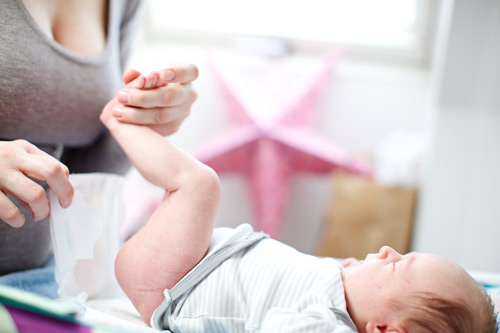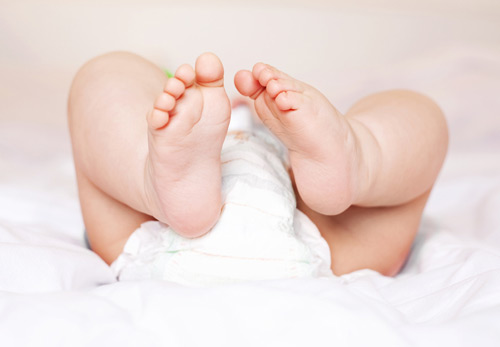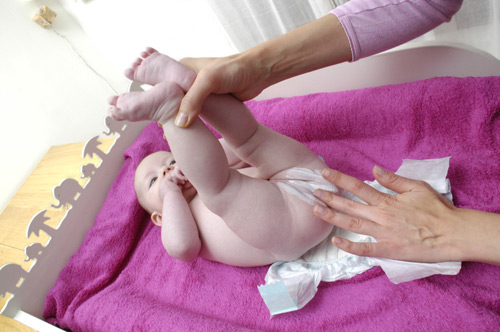Diaper Rash

Babies need constant care and affection. New parents want nothing more than their new edition to be happy and healthy. Almost all parents will have to deal with one of the common baby skin conditions. You start to change your baby's diaper, and suddenly - a patchwork of bright red skin on your baby's bottom. Don't panic, all babies get some level of diaper rash! What you're seeing is most likely common 'diaper rash', a common form of inflamed skin (dermatitis). Moisture, chafing and acid present in soiled diapers cause diaper rash. To prevent the rash, change your baby's diaper as soon as it gets wet. Apply a protective coat of Epizyn, or other doctor recommended topical with each diaper change.
There are many misconceptions about a baby's bottom:
- It is supposed to be perfectly smooth and rash-free.
- Diaper rash is abnormal.
- Diaper rash is a sign of food or formula allergies.
- Diaper rash means the baby has bad diarrhea or a yeast infection.
Having a diaper rash is a normal part of being a baby. There are many ways you can limit the amount of rash, but from time to time it will flare up again.
Why Babies Get Diaper Rash
Starting with ultra sensitive skin, change of seasons, add the chemicals and moisture of urine and stools, cover the area with a diaper that rubs back and forth, and you have diaper rash. This damaged skin is susceptible to the invasion of bacteria and yeast, which can make the rash worse.
What Does Diaper Rash Look Like?
Diaper rash usually causes mild redness and scaling where the diaper touches your baby's skin. In bad cases, the rash can cause pimples, blisters and other sores. If your baby's rash gets infected, the rash may be bright red and the skin may be swollen and even weep. Small red patches or spots may spread beyond the main part of the rash, even outside the diaper area.
What If My Baby Has An Infection?
If your baby also has an infection with the rash, the rash may not get better by following these tips alone. Your doctor might give you a prescription for a special antifungal cream to use on your baby's rash.
What About Powder?
Talcum powder and cornstarch aren't recommended. Talcum powder can get in your baby's lungs, and cornstarch may make a diaper rash worse if it was caused by a yeast infection.

Cloth Or Disposable Diapers?
The choice is entirely up to you. Some research suggests that because disposable diapers are more absorbent, they keep babies drier.
If you use cloth diapers and wash them at home, boil them for 15 minutes on the stove after washing them to kill germs and remove soap that could irritate your baby's skin.
6 Ways To Help Prevent Diaper Rash
If your baby does not have a problem with diaper rash, then you don't need to be too strict with these preventative measures. However, if you are constantly battling rash, here are some helpful hints to minimize it:
- Change diapers frequently - at least every two hours in newborns. You can space this out as baby starts to urinate less often.
- Change poopy diapers right away - this is a lot of trouble at first since newborns often have small, frequent stools. This will slow down as baby grows.
- Try different brands - if using disposables, another brand may fit a little better and cause less friction.
- Rinse cloth diapers - add a half-cup of vinegar to the rinse cycle. This helps remove alkaline irritants. Your diaper service can also do this.
- Wipe well - be sure to wipe all the stool and urine away.
- Use unscented wipes or just plain water - these are less irritating. You can even rinse out the wipes with water, although this takes more time.

4 Ways to Treat Diaper Rash Flare-Ups
No matter how diligent you are with the above measures, your baby will still have a rash from time to time. Here are some tips to treating those rough spots:
- Wash off bottom with water - don't wipe the sore areas. Instead, use a bulb syringe to gently wash baby's diaper area.
- Gently dab or pat away any remaining stool. Blot baby's bottom dry.
- Let it air out - leave the diaper off for a while, with no diaper cream on. Lay baby on a towel (with a waterproof pad underneath to catch accidents) with her bottom up. Do this as often as you can. This will help dry out the rash, which is important for the healing process.
- Diaper cream - when you do put the diaper back on, use generous amounts of cream.
Here are some suggestions:
Zinc gluconate - for the moderate to severe rash. (Epizyn is recommended by doctors)
Acid mantle - a very fine slightly acidic film on the surface of the skin acting as a barrier to bacteria.
Butt paste or Triple paste - there are a variety of creams that a pharmacist can mix up for you that contain a variety of ingredients. These are good for moderate rashes.
Clotrimazole anti-fungal cream - for stubborn rashes, yeast may be involved. You can add this over-the-counter cream to help.
Hydrocortisone 1% cream - you can put this over-the-counter cream on twice a day beneath any of the other creams to help with severe rashes. It will help with the inflammation. Don't use this for more than several days at a time as long-term use can damage the sensitive skin in the diaper area.
Lanolin - An ointment containing pure lanolin is excellent for treating the most stubborn rash as well as soothing sore bottoms.
Identifying Specific Diaper Rashes
Contact diaper rash - this is simply the regular rash as discussed above.
Appearance - flat, red irritated skin. When severe, skin will peel or blister and slough off.
Treatment - as described above.
Intertrigo - this is a specific rash that occurs within the skin folds and creases around the diaper area where the skin rubs together.
Appearance - Heat and moisture mixed with urine cause a red, burn-like appearance.
Treatment - regular white petroleum diaper ointment.
Yeast rash - when the skin is damaged, yeast from the intestines can invade the skin. This especially occurs with antibiotic use or prolonged rash.
Appearance - it is a red, raised, patchy rash with sharp borders, mostly over the genitalia but with satellite spots sprinkled around the diaper area.
Treatment - in addition to the above measures, there are two commonly used anti-fungal creams:
- Clotrimazole - over-the-counter. Apply 2- 3 times a day beneath the other creams.
- Nystatin - prescription. Not necessarily better, just different.
- Acidophilus - this is a natural bacterial powder that fights off yeast.
Impetigo - this occurs when bacteria invade the damaged skin.
Appearance - coin-sized blisters or red raised patches that ooze a honey-colored crust.
Treatment - prescription antibiotic ointment as well as the above general measures.
Seborrhea - an inflammatory condition that can affect different parts of the body, but can be especially severe in the diaper area.
Appearance - a big, red, sharply demarcated patch over the groin, genitalia, and lower abdomen. It can be more raised, rough, thick, and greasy than the other rashes.
Treatment - hydrocortisone 1% cream (over-the-counter) 2 - 3 times a day. Don't use more than a week unless directed by your doctor.
Allergy ring - a variety of foods can irritate baby's bottom, especially acidic foods such as citrus and tomato-based sauces.
Appearance - a red ring around baby's anus.
Treatment - discontinue suspected foods. Breastfeeding moms may need to eliminate foods from their diet.
When to Worry
None of the diaper rashes discussed here are so serious that they warrant an urgent call to your doctor in the evening or overnight. They generally can wait to be evaluated and treated by your doctor's office the following day.
Call Your Doctor if:
- The diaper rash occurs in the first 6 weeks of life.
- Pimples and small ulcers form.
- Your baby has a fever.
- Your baby loses weight or isn't eating as well as usual.
- Large bumps or nodules appear.
- The rash spreads to other areas, such as the arms, face or scalp.
- The rash doesn't get better after trying the tips on treating diaper rash for 1 week.
 PREGNANCY
PREGNANCY  GIVING BIRTH
GIVING BIRTH  BABY CARE
BABY CARE  HEALTH & SAFETY
HEALTH & SAFETY  FUN STUFF
FUN STUFF  FAMILY
FAMILY 